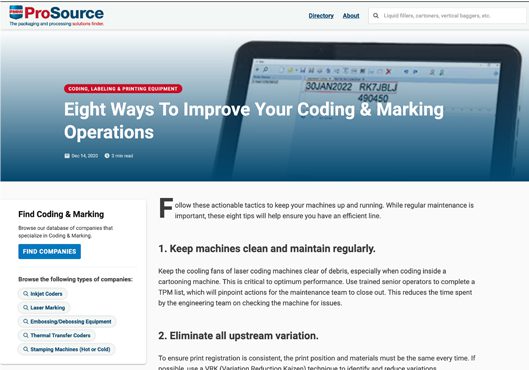Eight Ways To Improve Your Coding & Marking Operations
Follow these actionable tactics to keep your machines up and running. While regular maintenance is important, these eight tips will help ensure you have an efficient line.
1. Keep machines clean and maintain regularly.
Keep the cooling fans of laser coding machines clear of debris, especially when coding inside a cartooning machine. This is critical to optimum performance. Use trained senior operators to complete a TPM list, which will pinpoint actions for the maintenance team to close out. This reduces the time spent by the engineering team on checking the machine for issues.
2. Eliminate all upstream variation.
To ensure print registration is consistent, the print position and materials must be the same every time. If possible, use a VRK (Variation Reduction Kaizen) technique to identify and reduce variations.
3. Check and record non-coding parameters.
For effective coding and marking, it’s key that all components are operating in concert to create a smooth operation. Check that package motion drivers are operating within parameters to prevent skew, flutter, and random slip. Also check parameters such as backpressure, conveyor rail position, and any other components specified by the manual. Verify system parameters such as lighting and focal sharpness of lenses.
4. Use the recommended ink!
This is the simplest and most cost-effective way to get the best performance from your coding and marking machines. Purchasing managers are always bombarded with opportunities to save money, and low-cost ink supplies are always attractive. But keeping coding machines running 100% of the time is essential to efficiency, so spend the money to use high-quality inks. Often, the most expensive ink to buy is the least expensive ink to use.
5. Mind the ink.
Ink jet printers are subject to settling and thickening of the ink. When rotating a coder out of service for maintenance, flush it immediately to clear out old gunk. When it’s ready to go back in service, run the printer in the shop for at least 30 minutes to make sure the ink viscosity has normalized before moving it to production.
6. Protect coding machines from vibration and shock.
Conveyors and product on the line can introduce significant sources of vibration. Look into developing a shock absorbent platform for the machines that keeps them at a centerlined distance from the line and also helps keep them resistant to shock caused by line plugs or conveyors.
7. Control the environment.
Always try to control the temperature and humidity at the printing area in a stable range. This promotes proper ink flow and adhesion. When finished, make sure that you leave the coding print head as clean as it was before you started printing.
8. Reduce variability and errors.
With digital and variable print, consider what can be pre-printed from your vendor so packaging line operators don’t have to worry about coding and marking as a part of their duties. Keep product sensors clean at all times, make sure pouch-coding equipment will sense an empty pouch, and keep conveyor speeds constant. Are you case coding with inkjet? Ensure your guiderails are properly aligned with your cases and print head to improve print quality and reduce downtime.
Click the image below to view the online article

